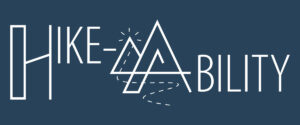Your cart is currently empty!

PAIN… a “Four-letter Word” that Doesn’t Belong on the Trail.
—
by
PAIN…

We’ve all experienced it to some degree, whether an all-out debilitating pain that sidelines you, or a nagging day-to-day discomfort that just keeps showing up. Needless to say it’s not desirable, and it definitely doesn’t enhance one’s experience on the trail.
Do you suffer with knee pain or back discomfort on the trail?
You can try to modify, avoid, or stop doing something that hurts, and it will likely temporarily decrease your symptoms in the short-term, but it’s rarely a final solution. Chances are, the pain will eventually return because you never actually addressed why the problem(s) started in the first place. The real solution is identifying “faulty links” within your body’s kinetic chain, and then working to restore proper movement and function.
Kinetic Chain
The kinetic chain is a way in which the body’s joints, muscles, and nerves interact with, respond to, depend on, and influence one another during movement. When this system is performing optimally the body moves more freely and efficiently. However, when there is a disruption at any level within the chain it results in dysfunctional movement patterns, decreased range of motion, chronic pain, and increased susceptibility to injury. A “faulty link” within the system will affect the links above and below it. This is why it might surprise you to know that poor ankle mobility can contribute to low-back discomfort, or that weak butt muscles can result in knee pain.
CAUSES OF KINETIC CHAIN DISRUPTION:
- Poor posture
- Chronic patterns (example: prolonged sitting)
- Muscle imbalances/asymmetries
- Muscle weakness
- Muscle tightness
- Prior injury

Example of Kinetic Chain Disruption
(POOR POSTURE):
Poor posture -> tight muscles in one area of the body -> weak muscles in another area
Weak muscles don’t engage/activate properly during movements -> other muscles (that aren’t designed to take on that load) try to compensate
Compensation -> excess load, tension, and stress on that muscle -> tightness & pain develops
Tightness & pain in the muscle -> restricted range of motion -> increased likelihood of injury
Injury -> further disruption of the kinetic chain -> dysfunctional cycle continues until you work to improve it
Chances are you have at least one area where your “links” need improving!
Do you experience knee pain while hiking?
The gluteus medius muscle (located on the outside of your buttock/hip region) serves an important role in movement, stability, and balance of the lower body. It functions to stabilize the pelvis, keep the hips level with walking, and is responsible for controlling how the knee tracks during movement. If this muscle is weak, the knee tends to cave inward, commonly resulting in knee pain.
- Short-term solution: Lighten your load; Use trekking poles
- Long-term fix: Strengthening the gluteus medius muscle can help correct knee tracking issues, and the associated knee discomfort often resolves. (Learn more about the importance of strength training for hiking fitness.) Incorporate mobility training.
- Exercises: Clamshells; Step-downs; Hip & ankle mobility exercises
Do you find hiking with a backpack results in a sore & achy upper-back?
Hiking with a backpack can further exacerbate poor posture (and the associated symptoms like pain and stiffness), especially if the muscles of the neck and mid-upper back are weak.
- Short-term solution: Properly fitting backpack that distributes load to weight bearing joints (hips).
- Long-term fix: Activating the small stabilizing muscles that you rely on for good posture, in addition to building endurance in these muscles, will prevent them from fatiguing and becoming achy when carrying a backpack. Incorporate mobility training.
- Exercises: Prone WYLT; Spine & shoulder mobility exercises
Do you suffer with low-back pain while hiking?
Low-back pain can often be the sign of weak muscles, and commonly it’s the glutes (butt muscles) and core that are the weak link. When a muscle becomes weak or doesn’t activate properly, our bodies find ways to compensate and “adapt”. But it comes with a cost, in the form of pain, tightness, stiffness, and/or injury.
- Short-term solution: Lightening your load; Properly fitting backpack
- Long-term fix: Activate and strengthen gluteal and core muscles. Incorporate mobility training.
- Exercises: Glute Bridge; Dead-Bug; Hip & ankle mobility exercises
Pain is the body’s way of communicating to you that something is potentially wrong and that you need to take action to correct it.
If you want to identify and properly address disruptions in your kinetic chain, enroll in my HIKE-ABILITY Training Program. Inside the program you’ll have access to 15 self-assessments that will identify YOUR specific areas of inefficiencies. PLUS, you’ll get complete exercise descriptions and videos to help build a more resilient and pain-free hiking body.
Kristen, CPT and creator of the HIKE-ABILITY Training Program

Disclaimer: All information, content, and material (including associated text, videos, and links) on this website is provided in good faith and is for informational and educational purposes only. It is not intended to serve as a substitute for the consultation, diagnosis, and/or medical treatment of a qualified physician or healthcare provider. All exercise has inherent risks. Before beginning any type of exercise, please consult your health care provider.




Leave a Reply